Alaska Towns in the Path of Climate Change

Alaska — In the dream, a storm came and Betsy Bekoalok watched the river rise on one side of the village and the ocean on the other, the water swallowing up the brightly colored houses, the fishing boats and the four-wheelers, the school and the clinic.
She dived into the floodwaters, frantically searching for her son. Bodies drifted past her in the half-darkness. When she finally found the boy, he, too, was lifeless.
“I picked him up and brought him back from the ocean’s bottom,” Ms. Bekoalok remembered.
Laid out on a narrow spit of sand between the Tagoomenik River and the Bering Sea, the village of 250 or so people is facing an imminent threat from increased flooding and erosion, signs of a changing climate.
With its proximity to the Arctic, Alaska is warming about twice as fast as the rest of the United States and the state is heading for the warmest year on record. The government has identified at least 31 Alaskan towns and cities at imminent risk of destruction, with Shaktoolik ranking among the top four. Some villages, climate change experts predict, will be uninhabitable by 2050, their residents joining a flow of climate refugees around the globe, in Bolivia, China, Niger and other countries.
At least two villages farther up the western coast, Shishmaref and Kivalina, have voted to relocate when and if they can find a suitable site and the money to do so. A third, Newtok, in the soggy Yukon-Kuskokwim Delta farther south, has taken the first steps toward a move.
In Shaktoolik, as in other villages around the state, residents say winter is arriving later than before and rushing prematurely into spring, a shift scientists tie to climate change. With rising ocean temperatures, the offshore ice and slush that normally buffer the village from storm surges and powerful ocean waves are decreasing. Last winter, for the first time elders here can remember, there was no offshore ice at all.
The state of Alaska — which in the past provided some funds to Newtok, allowing the Y’upik community to begin its move across the river to safety — is in a fiscal crisis, its economic health tied to oil revenues. And a federal lawsuit filed by one village against oil and coal companies, seeking relocation money as compensation for their air pollution, went nowhere.
Full article from NYTimes



























